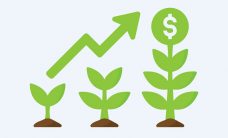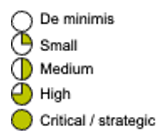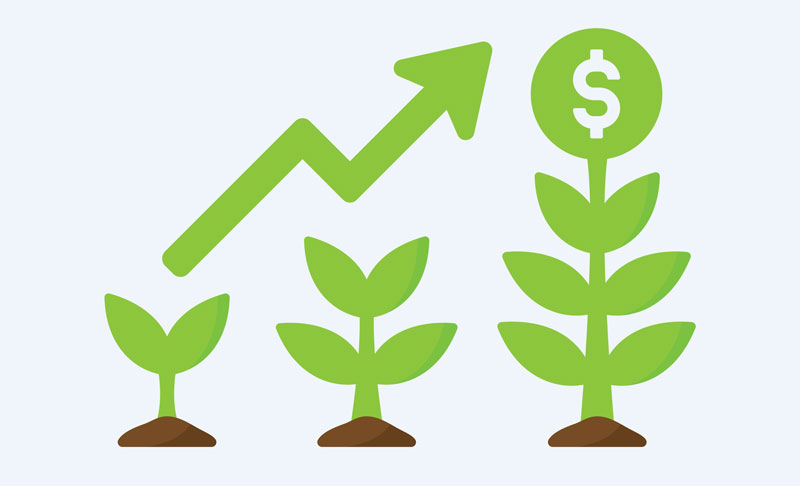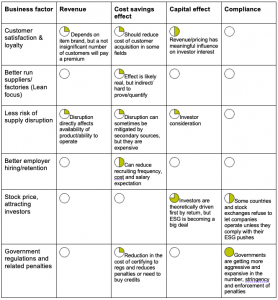 Adobe Stock
Adobe Stock
The business problems that people and companies face from the Covid crisis and other concerns related to environmental, social and governance (ESG) issues can be tackled with sound tactics and specific technologies that bolster sustainability goals and help a business’s bottom line.
In 2020 and 2021, several extraordinary events impacted all of us, both at home and at work. Covid is an obvious one — extreme weather was another, but also social and political change. All of these events forced us to reduce our movements, to work from home, often while watching the kids, and to cope with various supply chain shortages and/or longer lead times.
The impact of these events shows how our modern world is volatile, uncertain, complex and ambiguous (VUCA). On top of that, globalization acted as a catalyst. Interdependence of the world economies, cultures and populations created the “ideal” conditions for a catastrophic domino effect.
And the sad thing is that we created these conditions. Human activity is a major cause, and we are now paying the price of years of inaction. If we focus on work and the role that procurement plays, many organizations were victims of a self-inflicted injury that jeopardized their capacity to operate during the Covid crisis. They were (and still are) highly dependent on a very limited number of suppliers. And the race for hyper-efficiency created a “perfect storm” as organizations reduced their inventories to the bare minimum (if they existed) and put just-in-time processes in place. All of this created an almost zero tolerance for glitches by suppliers and/or on routes from suppliers, especially on such a global scale.
As part of Spend Matters’ research series on ESG issues and technology, I have been exploring solutions to these issues. And in prepping for a Jaggaer webinar series — which for attendees is worth educational credits with the Institute for Supply Management (ISM) — I’ve put together more thoughts on taking steps to address sustainability and ESG goals.
So, there is a positive side to all of this.
It is not yet too late to make changes, and these events can be a wake-up call for individuals and organizations. However, the changes have to happen on several fronts with the aim of reducing the likelihood and severity of events like the ones mentioned above and also reducing their ability to propagate.
It’s about changing today to create a sustainable future for us and the next generations
To create a meaningful, tangible and long-lasting effect, using fear is not enough to fight complacency. Sustainability is too often tackled (at least by organizations) by approaches that focus solely on the protection of the bottom line; some sort of a defensive approach. However, there is more to it.
First, sustainability can be a source of value creation for an organization. Furthermore, it is not just about the bottom line of an organization, as CEO Tim O’Reilly has said.
| “The obligation and the self‑interest of every company is to build a robust society.”
— Tim O’Reilly, founder, CEO, and Chairman of O’Reilly Media, and a partner at several venture firms |
Sustainability framework
The concept of “sustainability” finds its origin in 1987 when the World Commission on Environment and Development published a report on sustainable development. In a nutshell, the report states that “the exploitation of resources, the direction of investments, the orientation of technological development and institutional change [have to be] consistent with future as well as present needs.”
To achieve this, it proposes a framework made up of three pillars: the economy, society and the environment. It also considers interdependencies in the ecosystem. That framework is known as the 3Ps of sustainability or as the “triple bottom line” (TBL or 3BL), a term coined in 1994 by John Elkington, an authority on corporate responsibility and sustainable development.
The 3Ps of sustainability:
- Planet: It relates to lessening the impact on the environment that a business has (e.g., pollution, renewables, impact on natural ecosystems, etc.).
- People: This refers to everyone affected by the operations of a business. It includes employees and covers aspects like fair and beneficial working conditions, education, etc. It also encompasses upstream and downstream (customers & suppliers) and adjacent scopes (local communities).
- Profit: This refers to the economic value generated by an organization, not just for itself (which is the baseline for traditional corporate accounting) but also for its environment and society as a whole.
The 3Ps highlight that any human activity more or less directly creates/destroys value for a broad set of stakeholders. These include:
- Primary stakeholders — They are the ones directly related to a company’s activity, namely: employees, customers, suppliers and shareholders/investors.
- Secondary stakeholders — They are indirectly impacted and have an indirect influence on the organization. They are the environment, society at large, and the communities connected to the primary stakeholders (government, media, NGOs, etc.).
Also, tackling the sustainability challenge requires a change of perspective, to a more altruistic one. Usually organizations prioritize (to various degrees) their primary stakeholders. However, you should also give a voice to secondary stakeholders.
Social value and procurement
“Social value” is a way of thinking about how […] resources are allocated and used. It involves looking beyond the price of each individual contract and looking at what the collective benefit to a community is, when [an organization] chooses to award a contract. Source: CIPS
The change of perspective we mention is about assessing the true cost/benefit of an activity by taking a broader perspective rather than just the internal aspects. It is about the impact of that activity on all stakeholders, primary and secondary.
Several studies have shown that the main source of a company’s impact comes from its supply chain. Therefore, procurement has a major influence on an organization’s social value. It explains why topics like working conditions and environmental impact are getting more and more attention in procurement and compete with other more traditional value drivers (price, quality, etc.).
Therefore, it is critical to develop an ROI with regard to sustainability (S-ROI).
Sustainability/ESG is good for business and ROI
Sustainability can create value for an organization, and it is an opportunity for procurement to increase its value proposition and improve its brand. As Table 1 shows, sustainability can positively influence the bottom line and the top line.
Table 1

(click chart to enlarge)
From being the best in the world to being best for the world
An S-ROI approach also considers external impacts that must be taken into account. The benefits for the broader ecosystem rely on the creation of a virtuous cycle in the value/supply chains/webs. The increase in demand for sustainable products and services that an organization has will be reflected in its buying decisions and, therefore, drive its downstream supply chain to adopt a similar approach, leading to:
- Better management of shared resources and of the common environment
- An increase in revenue that is injected into the local economy (wages, taxes, donations, charities, etc.)
- A better resilience/anti-fragility of the overall ecosystem
How does procurement have an impact?
So far, we have looked at the internal and external benefits of a sustainability strategy. However, and as already mentioned, there are costs and challenges that must also be factored into the S-ROI. The costs pertain to embedding sustainability in the DNA of the procurement system (people, process, technology). Beyond the traditional hurdles (e.g., data, culture, behaviors, purpose) faced when managing a change, we should mention:
- Awareness — Sustainability (or some areas within sustainability) is a new topic and the lack of a structured methodology to account for (measure, calculate and report) the various impacts that it comprises (vs. the traditional P&L framework that is a well-defined and standardized methodology) requires investments in time, resources, external consulting, technology, etc.
- Busy-ness — Teams already have full plates, and sustainability adds to very busy agendas/priorities.
- Scale — Sustainability considers the end-to-end product lifecycle and supply chain (beyond tier 1), which can be difficult to manage and measure.
- Scope — Sustainability affects all procurement activities (see Table 2).
Sustainability must be embedded in all activities:
Table 2
| Process | Sub-process | Elements where sustainability/ESG plays a role |
| SXM | SIM — supplier information management |
|
| SPRM — supplier performance and relationship management |
|
|
| Category Management | Know your ecosystem |
|
| Product Lifecycle Management | PIM — product information management | Rich materials/product physical characteristics covering ESG:
Aggregation/roll-up of elements from parts to finished products (BOM) |
| NPI/NPD |
|
|
| S2C | Sourcing execution |
|
| Contract management |
|
|
| P2P | Guided “responsible” buying |
|
| Integration with systems of execution |
|
|
| Supply chain execution |
|
|
| Payments |
|
The examples we list are generic ones, and contextualization/localization is important. As far as the S2P process is concerned, this needs to be done at an even finer granular level — by categories. In addition, the elements and valuation of the ROI vary by zone where they apply. Measures/impacts do not have the same result, and the ROI can change from one region to the other. Therefore, depending on an organization’s footprint (including its supply chain), the focus on some or other components will differ at that level too.
Practical guide to getting started
At a high level, the translation of the S-ROI into procurement actions and activities revolves around an almost DMAIC/Six Sigma-like approach that consists of measuring, assessing, reporting and improving. It is a classical continuous improvement methodology. However, the challenges reside in the fact that:
- Sustainability is both a wide and deep topic. It covers multiple domains (each of the 3Ps can be broken down into multiple sub-elements), multiple layers of the supply chain and all procurement activities.
- Such an approach is data-hungry and even requires access to very specific data and information to develop the right knowledge/insights to be turned into actionable intelligence.
It is why many organizations can’t identify where to start. And, the fact is, there isn’t a one-size-fits-all answer. Each organization has to tailor its strategy to its own context. However, there are three design principles that we want to emphasize:
1. Building the case: Giving a voice to all stakeholders
- Identify primary and secondary stakeholders (using the concept of ecosystem and value chains/webs)
- Assess each stakeholder’s expectations with respect to the various dimensions of sustainability
- Loop back with the overall company strategy and vision on sustainability
2. Scoping and prioritization: Building an achievable S-ROI
- Build a baseline and identify opportunities/gaps looking at supply chain design and product design
- Assess your current footprint and impact (visibility into supply base and contracts)
- Leverage benchmarks and/or publicly available data to minimize data collection efforts in this “baselining” step
- Assess feasibility and viability
- Map stakeholders’ expectations to the characteristics/requirements of your products/services to identify levers to focus on
- Review your readiness and maturity to execute (people, process, technology, without forgetting enablers like data and culture)
- Tailor at category and/or region level
3. Implementation: Walk the talk
- Implement policies, guidelines and incentives (internal and external)
- Educate and evangelize beyond your walls (work with suppliers on making the case financially, environmentally and in relation to staff impact)
- Integrate sustainability at all stages (NPI and S2P) where key decisions are made
Related Articles
- Afternoon Coffee: Jaggaer’s ESG webinar series for procurement starts Thursday; Tipalti updates offerings, expands to UK
- ESG vendor profiles of Rheaply, Greenstone, &Wider, Givewith Procurement and Kountable: How ESG specialist solutions address sustainability efforts
- ESG vendor profiles of Circulor, SupplyShift, Transparency-One, FRDM and Wholechain: How supply chain visibility solutions address sustainability efforts
- Investor perspective: As Fortune 500 firms strive for ESG goals, investors can back ‘sustainability software’ in 8 growing technology markets
- ESG vendor profiles of IntegrityNext, riskmethods, Robobai, GoSupply, and Resilinc: How risk management solutions address sustainability efforts
- ESG vendor profiles of Kodiak Rating, State of Flux, Tealbook, Avetta, EcoVadis, SupplHi: How supplier management solutions (SXM) address sustainability efforts
- ESG vendor profiles of Coupa, GEP, Ivalua, Jaggaer, SAP Ariba: How S2P suite solutions address sustainability efforts



